Abstract
The capacity of the murine Listeria monocytogenes-specific T cell clone 9-36-1 and of lymphokines derived therefrom to induce antibacterial protection in vivo was studied. Clone 9-36-1 was stimulated to proliferate and to produce lymphokines by in vitro culture with syngeneic accessory cells and heat-killed L. monocytogenes. Although 9-36-1 cells were highly active in vitro, intravenous transfer of the cells resulted in marginal protection against a systemic infection with L. monocytogenes. In contrast, 9-36-1 cells injected subcutaneously together with L. monocytogenes into the footpad induced marked protection in syngeneic, but not in allogeneic, mice. Multiplication of Salmonella typhimurium was not reduced by the T cell clone. Studies with 51Cr-labeled T cells indicated that the low activity of intravenously transferred cells was due to an altered migration pattern. Lymphokines produced by 9-36-1 cells in vitro induced protection against L. monocytogenes in syngeneic recipient mice. Lymphokine-induced protection was also demonstrable in allogeneic recipients and against S. typhimurium. These findings suggest that the L. monocytogenes-specific T cell clone 9-36-1, although unable to immigrate into sites of bacterial deposition, had retained its ability to mobilize antibacterial defense mechanisms once present at the site of reaction.
Full text
PDF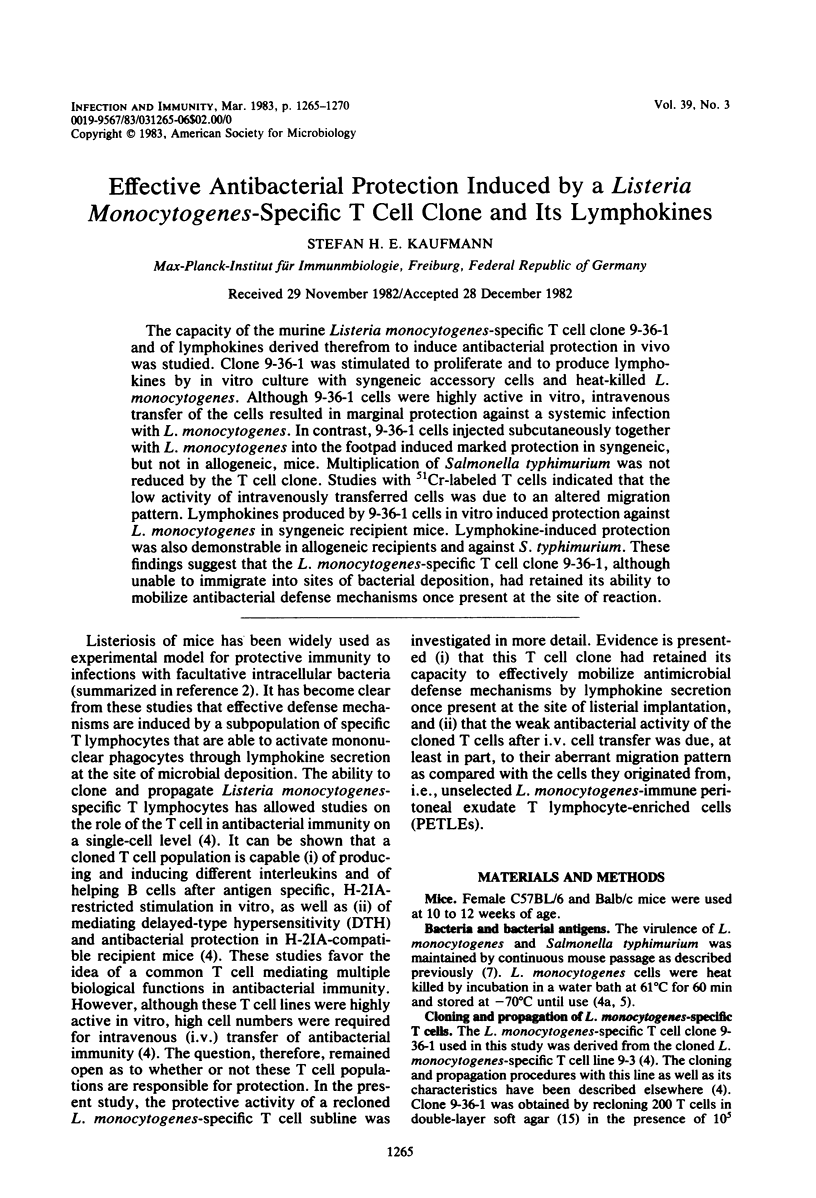
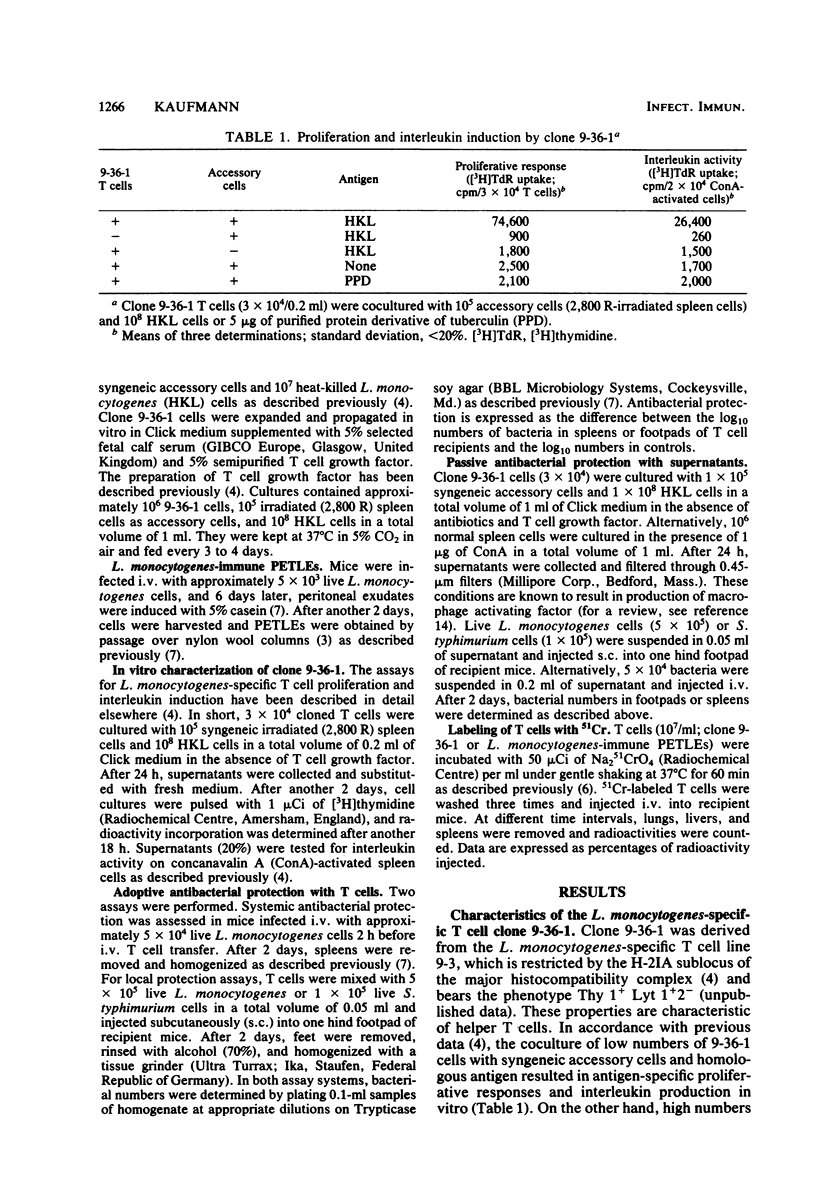
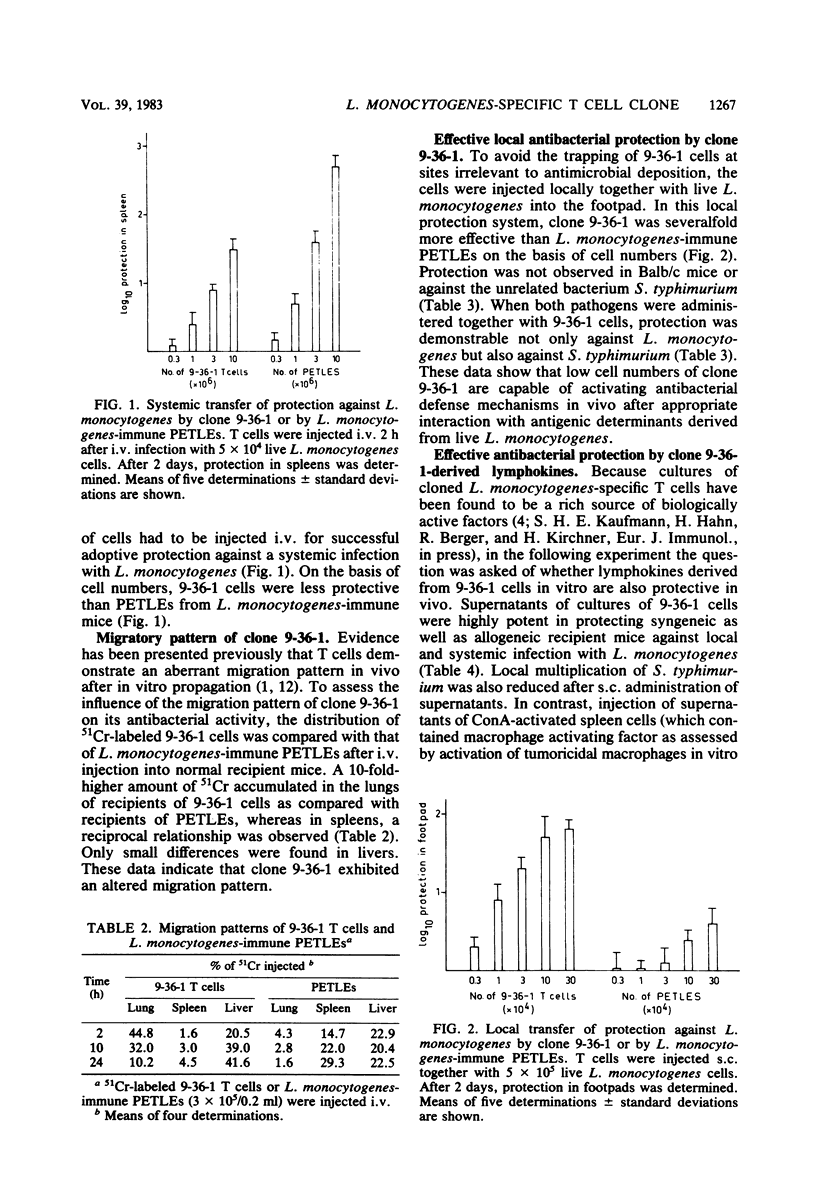
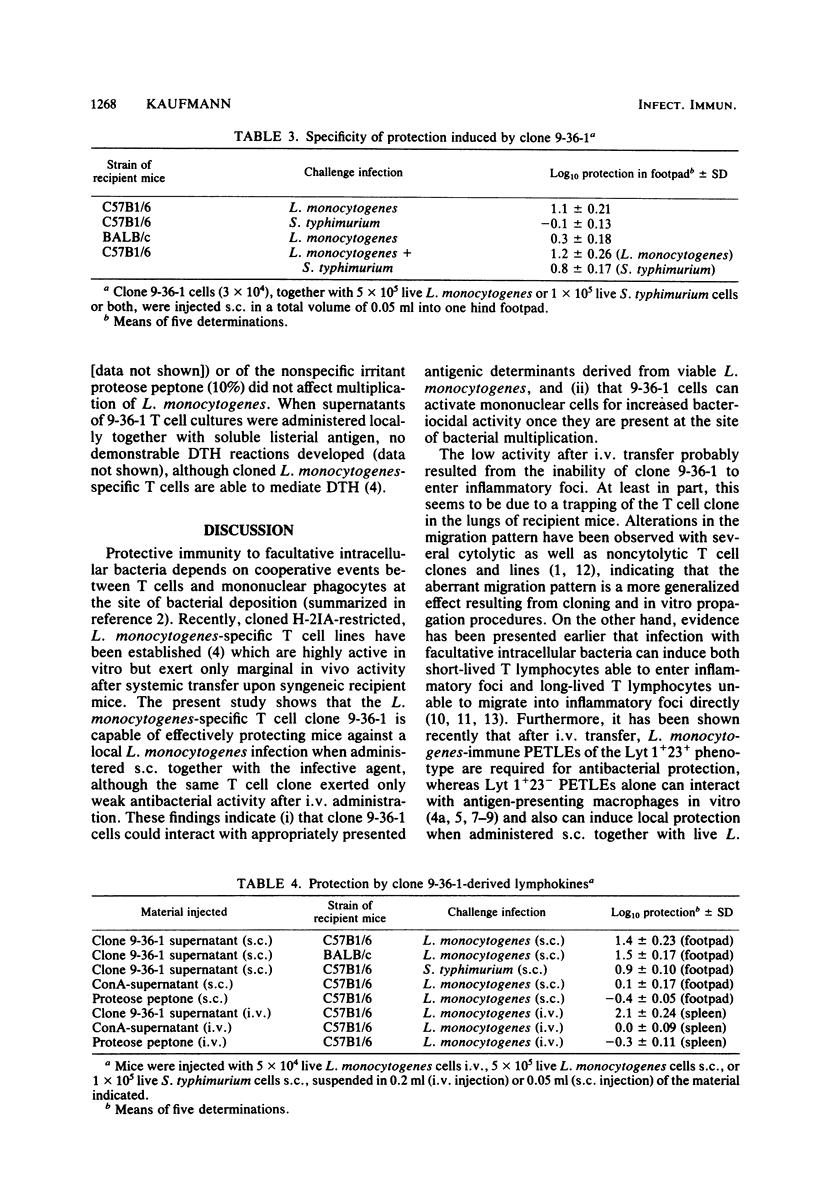
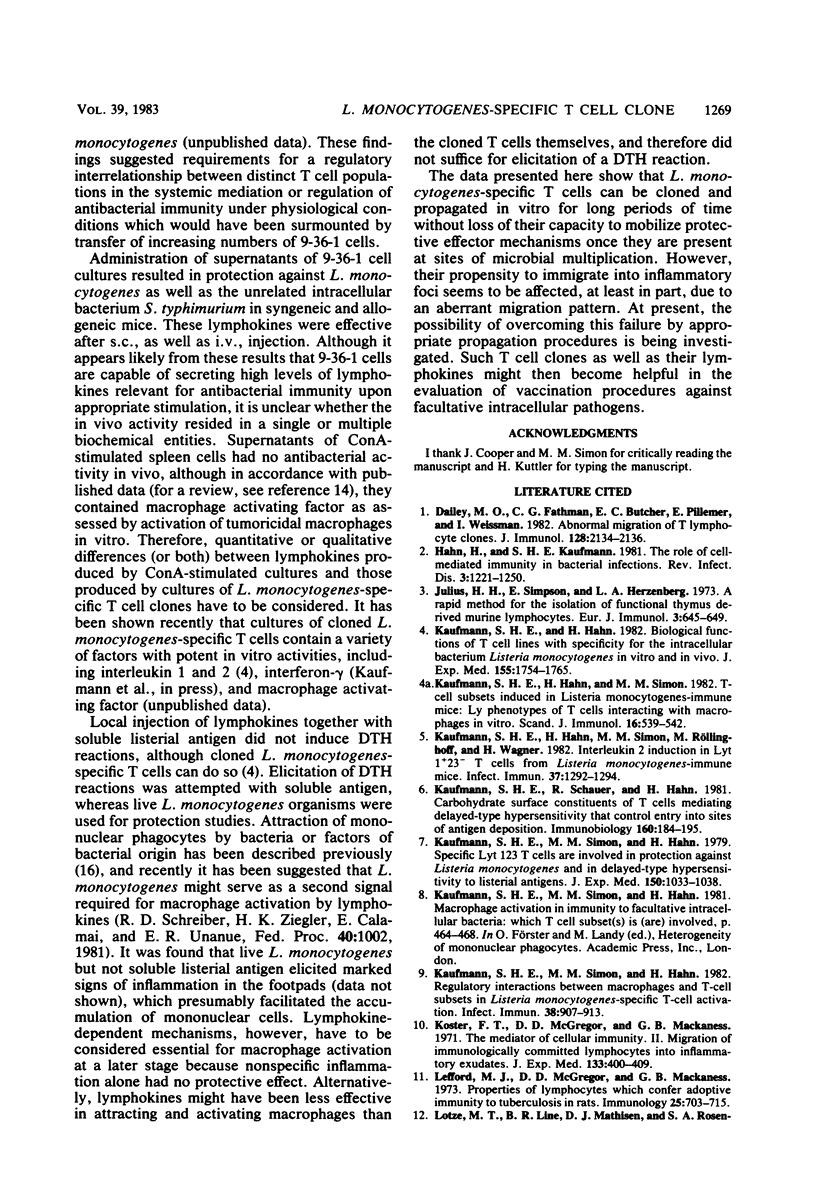
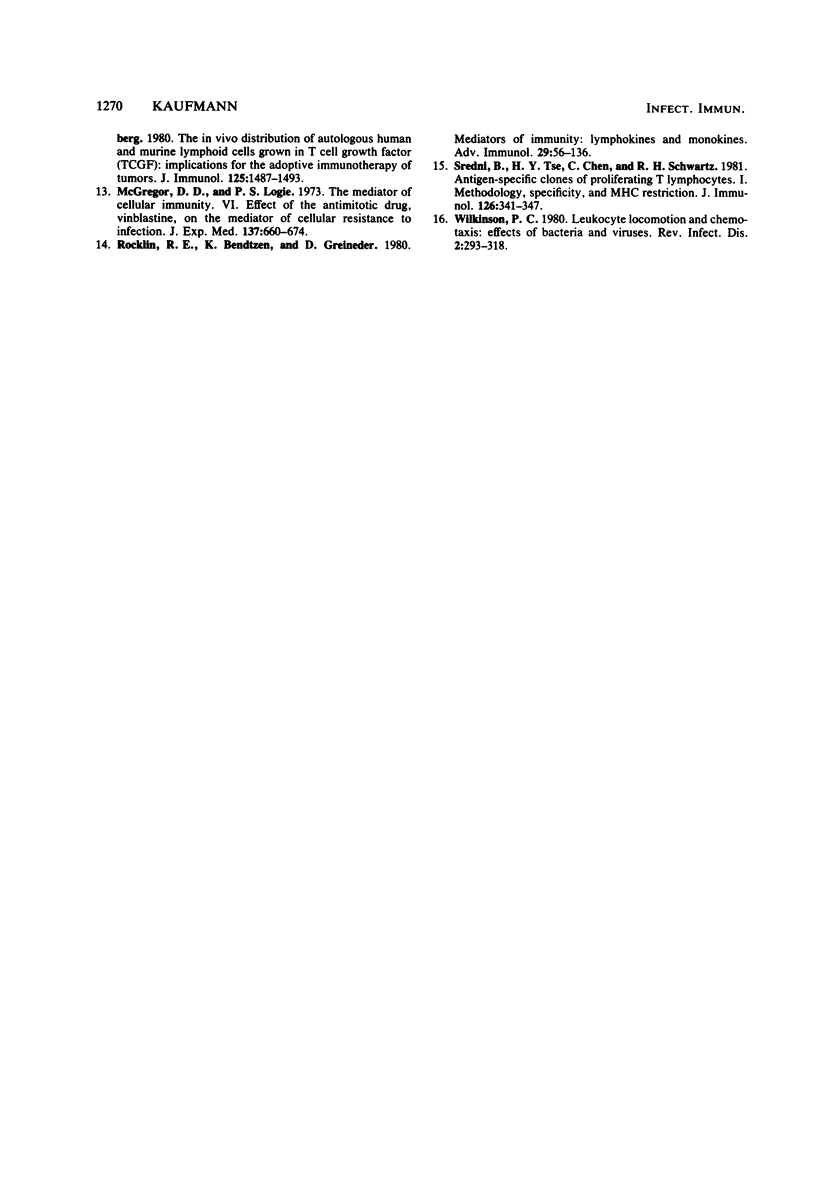
Selected References
These references are in PubMed. This may not be the complete list of references from this article.
- Dailey M. O., Fathman C. G., Butcher E. C., Pillemer E., Weissman I. Abnormal migration of T lymphocyte clones. J Immunol. 1982 May;128(5):2134–2136. [PubMed] [Google Scholar]
- Hahn H., Kaufmann S. H. The role of cell-mediated immunity in bacterial infections. Rev Infect Dis. 1981 Nov-Dec;3(6):1221–1250. doi: 10.1093/clinids/3.6.1221. [DOI] [PubMed] [Google Scholar]
- Julius M. H., Simpson E., Herzenberg L. A. A rapid method for the isolation of functional thymus-derived murine lymphocytes. Eur J Immunol. 1973 Oct;3(10):645–649. doi: 10.1002/eji.1830031011. [DOI] [PubMed] [Google Scholar]
- Kaufmann S. H., Hahn H. Biological functions of t cell lines with specificity for the intracellular bacterium Listeria monocytogenes in vitro and in vivo. J Exp Med. 1982 Jun 1;155(6):1754–1765. doi: 10.1084/jem.155.6.1754. [DOI] [PMC free article] [PubMed] [Google Scholar]
- Kaufmann S. H., Hahn H., Simon M. M., Röllinghoff M., Wagner H. Interleukin 2 induction in Lyt 1+ 23- T cells from Listeria monocytogenes-immune mice. Infect Immun. 1982 Sep;37(3):1292–1294. doi: 10.1128/iai.37.3.1292-1294.1982. [DOI] [PMC free article] [PubMed] [Google Scholar]
- Kaufmann S. H., Hahn H., Simon M. M. T-cell subsets induced in Listeria monocytogenes-immune mice. Ly phenotypes of T cells interacting with macrophages in vitro. Scand J Immunol. 1982 Dec;16(6):539–542. doi: 10.1111/j.1365-3083.1982.tb00756.x. [DOI] [PubMed] [Google Scholar]
- Kaufmann S. H., Schauer R., Hahn H. Carbohydrate surface constituents of T cells mediating delayed-type hypersensitivity that control entry into sites of antigen deposition. Immunobiology. 1981;160(2):184–195. doi: 10.1016/S0171-2985(81)80046-0. [DOI] [PubMed] [Google Scholar]
- Kaufmann S. H., Simon M. M., Hahn H. Regulatory interactions between macrophages and T-cell subsets in Listeria monocytogenes-specific T-cell activation. Infect Immun. 1982 Dec;38(3):907–913. doi: 10.1128/iai.38.3.907-913.1982. [DOI] [PMC free article] [PubMed] [Google Scholar]
- Kaufmann S. H., Simon M. M., Hahn H. Specific Lyt 123 cells are involved in protection against Listeria monocytogenes and in delayed-type hypersensitivity to listerial antigens. J Exp Med. 1979 Oct 1;150(4):1033–1038. doi: 10.1084/jem.150.4.1033. [DOI] [PMC free article] [PubMed] [Google Scholar]
- Koster F. T., McGregor D. D., Mackaness G. B. The mediator of cellular immunity. II. Migration of immunologically committed lymphocytes into inflammatory exudates. J Exp Med. 1971 Feb 1;133(2):400–409. doi: 10.1084/jem.133.2.400. [DOI] [PMC free article] [PubMed] [Google Scholar]
- Lefford M. J., McGregor D. D., Mackaness G. B. Properties of lymphocytes which confer adoptive immunity to tuberculosis in rats. Immunology. 1973 Oct;25(4):703–715. [PMC free article] [PubMed] [Google Scholar]
- McGregor D. D., Logie P. S. The mediator of cellular immunity. VI. Effect of the antimitotic drug vinblastine on the mediator of cellular resistance to infection. J Exp Med. 1973 Mar 1;137(3):660–674. doi: 10.1084/jem.137.3.660. [DOI] [PMC free article] [PubMed] [Google Scholar]
- Rocklin R. E., Bendtzen K., Greineder D. Mediators of immunity: lymphokines and monokines. Adv Immunol. 1980;29:55–136. doi: 10.1016/s0065-2776(08)60043-7. [DOI] [PubMed] [Google Scholar]
- Sredni B., Tse H. Y., Chen C., Schwartz R. H. Antigen-specific clones of proliferating T lymphocytes. I. Methodology, specificity, and MHC restriction. J Immunol. 1981 Jan;126(1):341–347. [PubMed] [Google Scholar]
- Wilkinson P. C. Leukocyte locomotion and chemotaxis: effects of bacteria and viruses. Rev Infect Dis. 1980 Mar-Apr;2(2):293–318. doi: 10.1093/clinids/2.2.293. [DOI] [PubMed] [Google Scholar]


